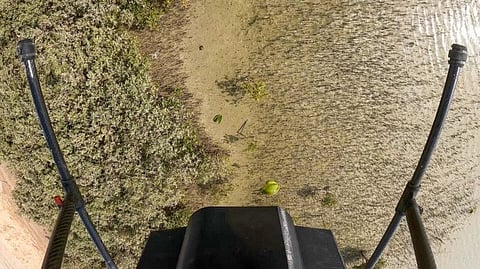UAE: Drones plant 1 million mangrove seeds in Abu Dhabi
Initiative supports country’s target to plant 100 million mangroves by 2030

Abu Dhabi: Abu Dhabi has successfully planted 1 million mangrove seeds using drones as part of the first phase of a project supporting the Abu Dhabi Mangrove Initiative.
The drone plantation was initiated by the Environment Agency Abu Dhabi (EAD), the emirate’s environment sector regulator.
The Abu Dhabi Mangrove Initiative was announced last February during a visit to the UAE by Prince William, the Duke of Cambridge, as he met with Sheikh Khaled bin Mohamed bin Zayed Al Nahyan, Member of the Abu Dhabi Executive Council and chairman of Abu Dhabi Executive Office, at Jubail Mangrove Park.
Mangrove conservation hub
This initiative, which is implemented by EAD with a series of local, regional and international partners, supports Abu Dhabi’s ambitious plans to establish the emirate as a global hub for research and innovation in mangrove conservation. It also acts on the importance of mangroves for carbon sequestration to combat climate change.
The Abu Dhabi initiative also supports the Ministry of Climate Change and Environment’s target to plant 100 million mangroves.
Why mangroves?
A mangrove is a shrub or tree that grows in coastal saline or brackish water. In the UAE, the species that is seen is Avicennia marina. This hardy tree acts as a natural windbreak, protecting coastal areas against tidal surges, and it also purifies the surrounding water. Mangroves are also highly effective at carbon sequestration, which contributes to the fight against climate change. In addition, the trees provide a safe home for hundreds of bird and marine species, this supporting biodiversity and increasing fish stocks.
Pilot phase
EAD is the first organisation to utilise and plant mangroves on a large scale utilising ecological principles, and enhanced by drone technology. The planting of 1 million seeds follows a successful initial phase implemented by EAD in partnership with ENGIE, the global energy company, and Distant Imagery, a drone engineering solutions company.
This pilot phase focused on planting mangroves via drone in 2020, with up to a 48 per cent success rate. EAD then scaled up the project, with 1 million mangroves planted via drones at different locations around Al Mirfa in Al Dhafra Region.
Benefits of drones
The use of drone technology to plant mangroves has several advantages. The environmental footprint of the methodology is low as it removes the need for intense labour or sapling transportation. It is also cost effective, as it reduces the overall price of mangrove planting, eliminates the need of mangrove nurseries and associated costs, and facilitates access to remote and difficult areas. The project is also running a trial on incorporating machine learning for future monitoring phases.
“The UAE began mangrove plantation in the 1970s under the guidance of the late Sheikh Zayed Bin Sultan Al Nahyan, Founding Founder of the UAE and also known as the first environmentalist [of the nation]. He commenced mangrove plantation along the coasts of the islands and mainland of the emirate of Abu Dhabi,” said Dr Shaikha Salem Al Dhaheri, EAD secretary-general.
Using the knowledge of local communities and his foresight, Sheikh Zayed passionately advised on, and supervised, the project. The Eastern Mangrove plantation was the inception of the first mangrove plantation programme of Abu Dhabi.
Mitigating climate change
“Despite the fact that the world’s mangroves are declining due to natural and human challenges they are facing, Abu Dhabi has a different story to tell. The plantation of mangroves has continued in the UAE at large, and in Abu Dhabi in particular, in a slow but steady manner. A prime example is our latest project of planting one million mangrove seeds via innovative drone technology,” Dr Al Dhaheri said.
“The success rate for this year’s planting looks great so far and based on the data, we will do a refilling of areas for future success of the project. This project is a continuation of our efforts to mitigate the disastrous effects of climate change as mangroves have proven to be very efficient at carbon sequestration, thus reducing the levels of carbon dioxide entering the atmosphere.”
Developing drone tech
With each planting round EAD has been developing its seed germination methodology, site planting patterns, seed dispersal mechanisms, and drone flight timesr. The drone is self-designed and engineered to drop seedlings from the air, amd to monitor the growth of mangrove saplings, map the habitat, and generate 3D imaging.
The EAD plans to further advance its methodologies and technology. Data has shown that the growth of the seed in-situ using drones has a success rate that remains stable over three years.
Increasing forest cover
In Abu Dhabi, plantation programmes have helped increase the range of mangroves. The increase of mangrove forest areas in Abu Dhabi has been more than 35 per cent, and is the result of plantation and restoration programmes, as well as protection laws and regulations, that ensure the sustainability of environmental ecosystems.
In the past 10 years, EAD and its key stakeholders, from both the government and private sectors, have planted more than 15 million mangroves along the coast of Abu Dhabi.
Sign up for the Daily Briefing
Get the latest news and updates straight to your inbox



